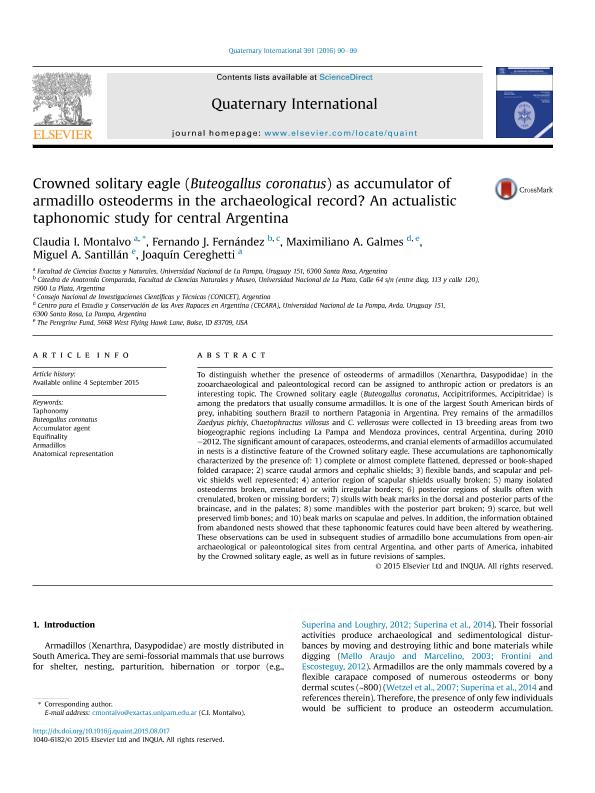Mostrar el registro sencillo del ítem
dc.contributor.author
Montalvo, Claudia Inés

dc.contributor.author
Fernández, Fernando Julián

dc.contributor.author
Galmes, Maximiliano Adrian

dc.contributor.author
Santillán, Miguel Ángel

dc.contributor.author
Cereghetti, Joaquín

dc.date.available
2018-07-31T18:22:19Z
dc.date.issued
2016-01
dc.identifier.citation
Montalvo, Claudia Inés; Fernández, Fernando Julián; Galmes, Maximiliano Adrian; Santillán, Miguel Ángel; Cereghetti, Joaquín; Crowned solitary eagle (Buteogallus coronatus) as accumulator of armadillo osteoderms in the archaeological record? An actualistic taphonomic study for central Argentina; Pergamon-Elsevier Science Ltd; Quaternary International; 391; 1-2016; 90-99
dc.identifier.issn
1040-6182
dc.identifier.uri
http://hdl.handle.net/11336/53619
dc.description.abstract
To distinguish whether the presence of osteoderms of armadillos (Xenarthra, Dasypodidae) in the zooarchaeological and paleontological record can be assigned to anthropic action or predators is an interesting topic. The Crowned solitary eagle (Buteogallus coronatus, Accipitriformes, Accipitridae) is among the predators that usually consume armadillos. It is one of the largest South American birds of prey, inhabiting southern Brazil to northern Patagonia in Argentina. Prey remains of the armadillos Zaedyus pichiy, Chaetophractus villosus and C. vellerosus were collected in 13 breeding areas from two biogeographic regions including La Pampa and Mendoza provinces, central Argentina, during 2010-2012. The significant amount of carapaces, osteoderms, and cranial elements of armadillos accumulated in nests is a distinctive feature of the Crowned solitary eagle. These accumulations are taphonomically characterized by the presence of: 1) complete or almost complete flattened, depressed or book-shaped folded carapace; 2) scarce caudal armors and cephalic shields; 3) flexible bands, and scapular and pelvic shields well represented; 4) anterior region of scapular shields usually broken; 5) many isolated osteoderms broken, crenulated or with irregular borders; 6) posterior regions of skulls often with crenulated, broken or missing borders; 7) skulls with beak marks in the dorsal and posterior parts of the braincase, and in the palates; 8) some mandibles with the posterior part broken; 9) scarce, but well preserved limb bones; and 10) beak marks on scapulae and pelves. In addition, the information obtained from abandoned nests showed that these taphonomic features could have been altered by weathering. These observations can be used in subsequent studies of armadillo bone accumulations from open-air archaeological or paleontological sites from central Argentina, and other parts of America, inhabited by the Crowned solitary eagle, as well as in future revisions of samples.
dc.format
application/pdf
dc.language.iso
eng
dc.publisher
Pergamon-Elsevier Science Ltd

dc.rights
info:eu-repo/semantics/openAccess
dc.rights.uri
https://creativecommons.org/licenses/by-nc-nd/2.5/ar/
dc.subject
Accumulator Agent
dc.subject
Anatomical Representation
dc.subject
Armadillos
dc.subject
Buteogallus Coronatus
dc.subject
Equifinality
dc.subject
Taphonomy
dc.subject.classification
Arqueología

dc.subject.classification
Historia y Arqueología

dc.subject.classification
HUMANIDADES

dc.title
Crowned solitary eagle (Buteogallus coronatus) as accumulator of armadillo osteoderms in the archaeological record? An actualistic taphonomic study for central Argentina
dc.type
info:eu-repo/semantics/article
dc.type
info:ar-repo/semantics/artículo
dc.type
info:eu-repo/semantics/publishedVersion
dc.date.updated
2018-07-31T17:20:53Z
dc.journal.volume
391
dc.journal.pagination
90-99
dc.journal.pais
Estados Unidos

dc.description.fil
Fil: Montalvo, Claudia Inés. Universidad Nacional de La Pampa. Facultad de Ciencias Exactas y Naturales; Argentina
dc.description.fil
Fil: Fernández, Fernando Julián. Universidad Nacional de La Plata. Facultad de Ciencias Naturales y Museo; Argentina. Consejo Nacional de Investigaciones Científicas y Técnicas; Argentina
dc.description.fil
Fil: Galmes, Maximiliano Adrian. The Peregrine Fund; Estados Unidos. Universidad Nacional de La Pampa. Facultad de Ciencia Exactas y Naturales. Departamento de Recursos Naturales. Centro para el Estudio y Conservación de Aves Rapaces; Argentina
dc.description.fil
Fil: Santillán, Miguel Ángel. The Peregrine Fund; Estados Unidos
dc.description.fil
Fil: Cereghetti, Joaquín. Universidad Nacional de La Pampa. Facultad de Ciencias Exactas y Naturales; Argentina
dc.journal.title
Quaternary International

dc.relation.alternativeid
info:eu-repo/semantics/altIdentifier/doi/http://dx.doi.org/10.1016/j.quaint.2015.08.017
dc.relation.alternativeid
info:eu-repo/semantics/altIdentifier/url/https://www.sciencedirect.com/science/article/pii/S1040618215007788
Archivos asociados
